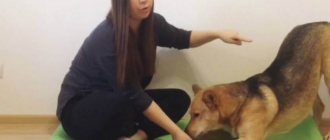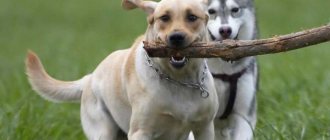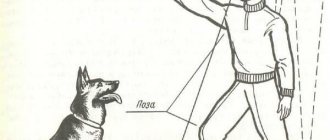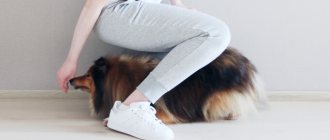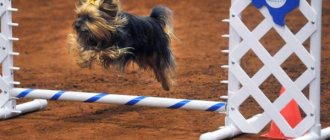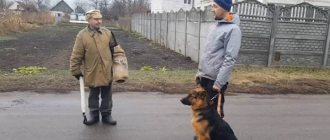The command “Bunny” or “Serve” is that the dog sits on its hind legs, raising its front legs. This is a fairly popular exercise, but not all dogs can do it. This trick is most suitable for small dogs with short backs, as it is easier for them to maintain balance. Large dogs and those with spinal problems find this exercise difficult.
How to teach your dog the “Serve” command
or
“Bunny”?
Very simple: say “Sit” and bring a treat to her nose.
Showing the dog a treat
Slowly raise your hand with the treat just above the dog's nose, and then move your hand slightly back behind the animal's head. If your pet stands up when reaching for a treat, correct him. Give the treat as soon as the dog sits with a straight back.
We pass a treat behind the head to encourage the dog to rise
You can attach the leash and gently pull the dog into the desired position. But under no circumstances pull your dog on a leash.
Repeat the exercise several times and enter the voice command “Bunny” or “Serve” when the dog understands the essence of the trick and will take the desired position without any problems.
The dog sits in the “Bunny” position
At first, it is enough for the dog to sit with his back straight for a few seconds. To teach your dog to do the “Bunny” without your help and freeze in this position for a long time , repeat the exercise several times, gradually increasing the intervals between the execution of the command and the reward.
"Serve" for small dogs.
Large pets learn to “Serve” somewhat differently than small breeds. The algorithm by which you can teach your pet to stand up is as follows:
- The command “Sit” is given.
- The owner stands facing the dog and gets down on one knee.
- With the help of a treat, the owner of the animal forces the dog to lift its head.
- Then he pulls the hand with the treat up so that the dog lifts its front paws off the floor.
- The command “Bunny” or “Serve” is given.
- The pet is treated to a treat.
Before rewarding the dog after performing the stand, you need to wait until the pet finds balance on its hind legs and stands in this position for a while. To train a dog to “Serve” fully, it is necessary to gradually increase the time spent in the stance and quietly move a short distance away from the pet.
When should you start training your puppy?
Any dog handler will answer this question this way: the sooner the better. However, it is worth considering that due to age factors, there are restrictions for some teams. Basic elements of training and education must be applied from about three months of age of the pet. After the dog has mastered them and can carry them out without any problems, you can move on to more complex commands and tricks. As a rule, by this time the puppy is 6-7 months old.
However, it is necessary to take into account the individual characteristics of the dog, the characteristics of the breed, its temperament and character. Those commands that are easily performed by a German Shepherd or Alabai will be difficult for a Dachshund or Pekingese, and they may take much more time to master. Therefore, it is very difficult to name the exact age for a specific team. In addition, the frequency and regularity of classes, the amount of time allocated for training, and the owner’s persistence play a role here.
“Serve” for large breeds.
Large breed dogs are much more difficult to train to “Serve” than miniature pets. A dog will never become an upright walker, so it is difficult for a large animal to maintain balance on its hind legs. Standard “Bunny” training here looks like this:
- The command “sit” is given.
- The owner stands behind the dog.
- With a treat, the dog is forced to lift its head and stand up for the treat.
- The pet is picked up under the paws by hand and commanded “Serve” or “Bunny”.
- Then they give the treat and praise.
Training a large dog involves supporting it with your hands in the first stages of training. An experienced dog handler may advise not to linger at this stage for too long, but to give the pet the opportunity to maintain balance on its own.
Another dog can show you how to do the bunny correctly. Training the “Bunny” should take place in a calm environment, where there are no cats, cats, or other irritants.
Basic and additional commands
All commands can be divided into two groups – basic (main or mandatory) and additional. The mandatory ones include the following:
- lie;
- stand;
- near (to me);
- sit;
- fu (impossible);
- place;
- walk;
- voice;
- stranger.
Having taught the pet these commands, the owner will be able to walk with him on the street without any problems, go to visit, visit crowded places, without fear that the dog will harm anyone or create an unpleasant situation.
Additional ones include:
- to guard;
- bunny (to serve);
- to spin;
- "ashamed";
- fetch;
- trench (the pet crawls under logs or other obstacles);
- seek;
- other.
Depending on the breed and the needs of the owner, the list of commands and tricks performed by the dog can be continued for a very long time. The main thing is to understand whether your pet needs these complex skills in everyday life. For example, raising service dogs and small pets will be radically different, in particular, the list of additional commands will be much larger.
Have you already tried it and it doesn’t help?
Enroll in an online school and solve your problem right now!
more details
Many people are interested in how to teach a dog the bunny command? We will talk about this in more detail later in our article.
“Serve”: working on mistakes.
Effective correction of a pet's behavior occurs gradually. If the pet does not understand what is required of it, then only a canine psychologist can help. Some animals are shy and are simply afraid to stand on their hind legs.
While executing the command, you need to make sure that the dog’s body does not fall on its side. The vertical position of the back when performing “Serve” is considered preferable. It is worth remembering that this trick can only be mastered by dogs that have no health problems and whose back is not a sore spot.
How to teach a dog commands: preparation
Preparing to train a dog includes:
- Understanding the goals: what exactly is expected as a result of working with the pet and what the efforts are aimed at. It is important to understand that some tasks are beyond the capabilities of a person without special education, and illiterate work will negate all efforts. In this case, it is right to seek help from an expert.
- Understanding the developmental characteristics of dogs. Often, owners demand too much from a puppy, not realizing that training is a systematic process that requires a lot of effort, time and patience. You need to start small, move gradually and not give your dog too many tasks.
- Planning work with a pet: dogs are not trained on a full stomach or after vigorous play. The learning process itself is a game for the animal, and it is about combining business with pleasure. After eating and walking, dogs usually sleep.
- Since skills are best developed using the “done - deserved” system , you need to prepare in advance to ensure that the gift is given at the most necessary moment. It is worth keeping treats “closer to the body”, because the training process involves an associative type of memory, which develops thanks to the created chain of actions. When the command is executed correctly, the reward should arrive immediately.
- Preparation of the “work site”. Nothing should distract the pet from work (strangers, other animals).
Regardless of what course you will follow in the future, the initial stage consists of a set of basic exercises, which are the basis of any training school. For both puppies and adult dogs, the development of primary commands must be carried out at home.
Where to start training and how long you need to train
A puppy is like a small child: it needs care, affectionate but demanding education and love. From the moment a puppy appears in the house, its upbringing and training must begin with accustoming it to a name and to being handled.
It is necessary to help the puppy to be in the company of people and other pets, not to be afraid of noisy or sharp sounds, to accustom him to order and daily routine..
Already at this age, when the puppy does not yet go outside, you should begin to accustom him to wearing a collar and a leash attached to it: the owner’s task is to convey to the baby that this is not scary.
At this stage, training will not take much time: 5-10 minutes a day for each skill, while constantly confirming the need for the behavioral reactions expected from the dog with your confident, calm behavior, and the puppy will be prepared for further, more serious training.
Do not tighten the collar too tightly (2 fingers should fit under it freely) or too loosely.
Expert opinion
Kozhevin Semyon Kirillovich
Expert dog handler.
You can train, for example, using one technique as a basis. Its essence lies in the fact that in each period of a dog’s growing up and life, one dominant motive of behavior stands out, most clearly expressed at a given stage of life, which is used as a motivator during training. A choleric Labrador will actively and joyfully work for the opportunity to play with a toy and run for a frisbee; an obvious food eater will follow commands for a special treat. That is, the reward for a correctly executed command can be anything, from your favorite crackers to games and affection.
Bow
This is done as follows. It is not difficult to train an animal, since the position of the body for the trick is not special. Many dogs, on their own, while playing with their relatives or stretching after sleep, arch their backs and stretch their front paws in front of their muzzle. To achieve the goal, you need to step on the leash with your foot, while simultaneously moving the treat from your nose forward with your right hand. This will allow you to show the animal that it needs to lie down, while the command “Lie down!” is not given. As soon as the dog begins to stretch its limbs forward, you need to give the command “Bow”. Successful performance of a trick in the initial stages of training is considered when the dog slightly tilts its body.
Dog training outdoors
Commands reinforced in dogs on the street are primarily necessary to create comfortable conditions for a walk. They are important both for the safety of the pet itself, and in order to avoid conflict between one’s own and someone else’s dog, as well as to prevent situations where the incorrect behavior of an animal jeopardizes relationships between people.
It goes without saying that the primary commands that the dog learned at home will now be practiced on the street, where the degree of excitement is higher and the pet (and the owner) need extreme concentration of attention.
To start training, the following recommendations will be useful:
- The dog must become familiar with the territory and not consider it foreign.
- Before starting work, the pet is walked.
- The beginning of training is carried out in a comfortable place, where there are the least irritating factors: people, cars and other animals.
- Treats are prepared in the pocket: reward follows immediately after a successfully completed requirement.
- There should also be a “rattle” at the ready - some kind of noisy thing that can alert or frighten the dog if it incorrectly carries out certain commands. The role of a rattle can be played by a jar of bolts and the like. How this works will be described below.
- You should not abuse training: there is nothing worse than a disgusting lesson.
- The street is full of temptations. This is not a place where the dog is punished by teaching commands. She must play, explore the surrounding space, communicate with her own kind. It is necessary to choose the right moment when the dog is ready to work and adapt to its mood.
The result is important: if the dog learned a lesson in a situation that it created itself (for example, it approached the owner when it had had enough of playing, but the command “come to me” was fixed in the subconscious), the result was achieved.
Other training options for “Bunny” (“Serve”)
You can teach your dog the “Serve” command in other ways. If your pet has trouble maintaining balance, try the following training options:
- Option 1: Let the dog lean on your hand, which is holding a treat. When the dog begins to understand the essence of the exercise, gradually remove your hand and teach him to raise his paws in the air without your help.
The dog leans on the hand to maintain balance
- Option 2: Place the dog in the corner of the room close to the walls so that they provide additional support. Then use treats to force the animal into the desired position.
Walls help dogs balance
- Option 3: Tell your dog to “Sit” and stand behind him as close as possible (heels together, toes apart, knees supporting the animal’s back). Use treats to encourage her to get up.
The pet performs “Serve”, relying on the trainer.
Source
Basic mistakes
During training, you should not overdo it with the same commands. Labrador Retrievers can become bored with the monotony of tasks. Numerous fetchings will provoke a refusal to bring toys to the owner.
If the dog gets off the leash and runs, there is no point in catching up with him. You need to shout “to me” in a demanding tone. Chasing can be perceived as a game by your Labrador.
Dogs should not be allowed to stay in the water for long periods of time. Animals love to swim; when they feel out of control, they will ignore the trainer’s calls and go ashore.
Tips from dog handlers
Recommendations that dog handlers do not recommend neglecting:
- Study the characteristics of the breed before purchasing a puppy. This will allow you to competently educate the creature and build an effective work scheme.
- Choose a suitable place to study. The room, the courtyard, should be quiet, spacious, and comfortable.
- Walk your dog regularly.
- Do not allow assault, even if the dog is very guilty.
- Monitor the schedule of necessary vaccinations. Visit veterinary clinics.
- Express dissatisfaction or praise fairly, after analyzing his actions.
- Give commands in a stern, non-rude tone. The dog should want to obey, not be afraid.
- Provide the animal with sufficient, balanced nutrition.
- Find time for tenderness every day. Don't neglect the opportunity to pet your pet. This will make the relationship between dog and owner warm and trusting.
- Don't give up on classes. Acquired skills require constant reinforcement.
Following the advice of dog handlers, even for novice dog breeders it will not be difficult to get a disciplined, wise dog.
Having mastered the basic skills of the training course, you need to move on to complicating the program. Labradors have great potential. With the right approach of the owner, it can be fully revealed. Then the dog will become not just a friend, but the main protector and assistant.
How to stop jumping on people
The need to jump, as a kind of greeting ritual, is formed from puppyhood. The purpose of such jumps is to get food. That is why the puppy strives to get to the face of the owner (or another person): he jumps instinctively, just as he bites.
In such situations, some advise stopping the dog with a knee strike and squeezing its front paws. You shouldn't do this. There are much more humane and no less effective methods.
You can, together with the command “No!” or “You can’t!” extend your palm towards the animal and step forward towards it or encourage alternative behavior .
NOTE!
You need to start weaning off jumping on people from puppyhood. If the Labrador is already an adult and has not been taught to restrain his emotions, experienced dog breeders advise wearing a halter and practicing self-control.
It is possible that the Labrador, as an extremely active and cheerful dog, will need quite a lot of time for this.
Experts advise practicing endurance on many, many people, in various situations, rewarding with treats for not jumping, then the desired behavior pattern will form and the dog will stop jumping..
If the dog is on a leash and is about to jump on someone, you need to sharply pull the leash.
Features of training an adult dog
It is more difficult to teach an adult dog commands than a puppy, but it is not impossible. However, it is necessary to understand: an adult dog that has not undergone socialization may have a formed psyche and ingrained habits, and the question in this case is not about training, but about adjustment or re-education. The ability to rebuild a behavior model depends on the dog’s temperament, its age, and degree of aggressiveness.
If it is obvious that you cannot cope on your own, you need to seek help from a professional. Modern training techniques in the hands of a good specialist work wonders.
The basic principles of training adult dogs remain the same:
- Training goes from simpler to more complex commands.
- In parallel, hierarchical settings are established. In sexually mature individuals, additional motives for developing dominant behavior associated with reproductive instincts are included, therefore, in a situation with an adult dog, it is extremely important to show the dog clear boundaries of what is permitted.
- Training should be systematic: even refined commands must be repeated periodically.
- It is important to be able to restrain emotions: fear, anger, aggression, impatience are not acceptable.
- Reinforcement follows immediately after a successfully completed command. Failure is accompanied by indifference and lack of reaction on the part of the owner.
As in the situation with young dogs, it is necessary to carefully observe the process, not to overtire the pet, learn to sense his mood, and most importantly, take his time.
How to stop pulling on a leash
Most often, the reason that a Labrador pulls on the leash is the incorrect behavior of the owner, who does not understand the psychology of the animal.
When a dog pulls on the leash, it means that it is in control of the situation, not the owner, and it becomes unclear who is walking whom.
To solve this problem you need to follow the following rules:
- keep the leash loose from the very beginning;
- when moving, periodically follow the dog and at times force it to turn in the direction you want, using a treat, toy or target;
- while moving, try to constantly maintain contact with the dog with your voice, gestures, and rewards for correct behavior;
- whenever the Labrador begins to pull on the leash, stop or walk back (the dog needs to understand that as soon as it pulls on the leash, the movement towards the goal stops, it is useless to resist).
Naturally, these rules are easier to apply when the Labrador is still small . Therefore, raising a dog, including weaning it off from pulling, must begin at an early age.
You should not solve the problem of a tight leash by putting on a strict collar or, especially, a shock collar ! Labrador is not a breed that requires such extreme measures.
How to toilet train and diaper at home
As a rule, the puppy urinates immediately after sleep/play/15 minutes after eating, and before cleansing the intestines, it worries for some time, looking for a comfortable place, sometimes whining.
Having noticed that the puppy is preparing to recover, you need to quickly draw his attention to yourself with some exclamation.
The pet will react, its urges will subside for a while, and there will be an opportunity to put a diaper on it. In this case, you definitely need to be patient and wait for the correction!
Over time, he will develop the necessary reflex, and when he needs to go to the toilet, he will do it in a diaper without outside help .
Training a mongrel
No one has yet created a special treatise “How to train a mongrel dog,” because the basic principles of training are the same as for other representatives of the canine community. Purebred dogs have genetic characteristics, according to which some pets tend to protect the territory, while others tend to conduct search work.
Mongrel dogs have a lot in their blood that no one is aware of, and many of them are much smarter than representatives of “high society.” If there is an exotic dog and a mongrel one on the street, the chances of success in survival will undoubtedly be on the side of the latter.
As with any other pet, it is correct to start training a mongrel from puppyhood (3-4 months), following the basic rules of training.
Punishment and reward
The behavior of even the most well-mannered dogs sometimes causes criticism. In order for the puppy to understand his mistakes, you need to correctly point out them. It is important to focus on your pet’s good deeds. This will reinforce positive behavioral skills in your Labrador.
It is necessary to think over a scheme of praise and punishment. Both methods must be present in the process of developing the Labrador's character.
Expert opinion
Anna Abramenko
An avid dog lover. Experience in veterinary medicine since 2009.
Ask a Question
Puppies are often mischievous during childhood. This requires a prompt response from the owner. You need to let the animal know that it did something bad. It is permissible to point out the damaged item, say strictly “ugh”, and not play with your pets for the next hour.
The baby relieved himself in the house because the owner did not take him for a walk - you cannot scold a pet. The man himself provoked such an act.
When a dog willingly follows the owner’s commands, it deserves a reward and should receive it immediately - a treat, praise.
Yelling at the animal or hitting it is strictly prohibited. Otherwise, he will grow up to be a frightened dog with mental problems.
